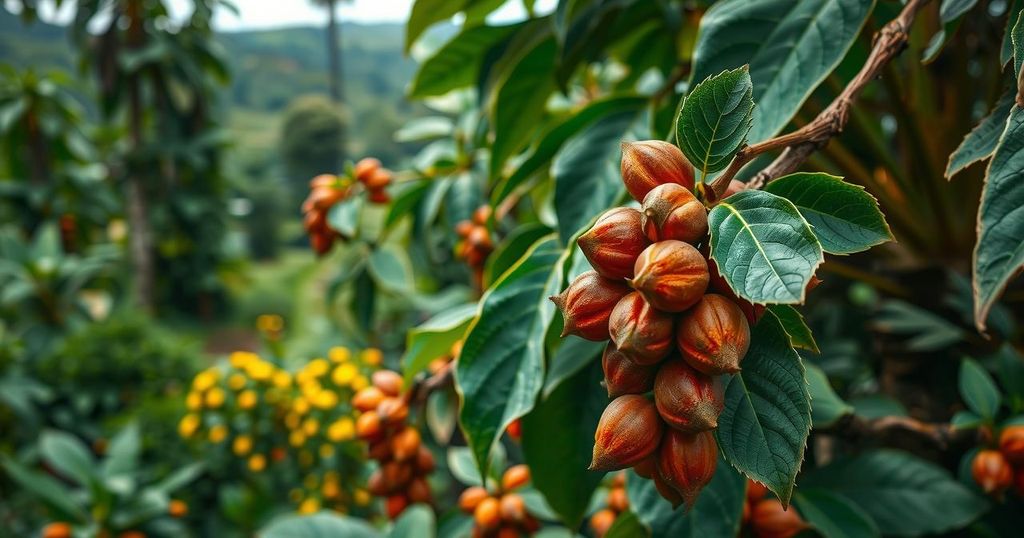Research by the University of Göttingen highlights the importance of shade tree leaf phenology in improving resilience and productivity of cocoa agroforestry systems in West Africa. Different functional groups of trees were classified based on their seasonal leaf behavior, revealing significant impacts on cocoa yield and soil moisture management. The study underscores the need for judicious selection of shade trees in response to climate change challenges.
In West Africa, which produces 70 percent of the world’s cocoa, the integration of agroforestry, which involves incorporating trees and shrubs into farming, is essential for sustainable cocoa cultivation. Climate change-induced droughts necessitate adaptations in agricultural practices. New research by scientists from the University of Göttingen emphasizes the significance of leaf phenology—seasonal leaf cycles of shade trees—in enhancing climate resilience in cocoa agroforestry systems. The findings indicate that these seasonal changes in foliage can significantly affect cocoa yield and resilience against environmental shifts, as reported in the journal Agriculture, Ecosystems & Environment.
Shade trees play a dual role by offering protection from extreme weather while competing for soil and light resources. Researchers conducted a two-year field study in Ghana’s northern cocoa belt to observe how various shade tree species impact microclimatic stability and cocoa productivity. The study classified shade trees into seven functional groups according to their leaf cycles, revealing that trees which entirely shed their leaves during the dry season help maintain essential soil moisture, thereby supporting cocoa crops through drought conditions. On the other hand, trees with shorter leaf-off periods can deplete soil water resources, negatively impacting cocoa in extended dry seasons. While evergreen trees demonstrate utility in temperate regions, they may increase disease risks in humid climates.
Dr. Munir Hoffmann from Göttingen University articulated, “By using functional groupings based on leaf phenology, rather than focusing on the huge number of individual species, we offer practical guidelines for selecting shade trees that support climate resilient cocoa production.” Dr. Issaka Abdulai, the lead author, remarked, “This study sheds light on the importance of leaf phenology as a guiding trait for selecting shade trees that will enhance cocoa resilience to climate change.” Professor Reimund Rötter further stated, “We have shown that, if chosen judiciously, shade trees can be allies in both sustaining cocoa productivity and enhancing environmental stability. Our results suggest a clear path forward for designing agroforestry systems that deliver higher resilience and sustainability. “,
This investigation received crucial support from the German Research Foundation (DFG), underscoring the collaborative efforts essential for progressing agroforestry practices and advancing climate resilience in cocoa farming across West Africa.
West Africa is a critical region for cocoa production, accounting for 70 percent of global output. The impact of climate change has intensified, particularly through increased drought conditions, threatening the viability and sustainability of cocoa farming in this area. To address these challenges, innovative farming practices, such as agroforestry systems that incorporate shade trees, are being researched and implemented. This method not only enhances cocoa production but also helps mitigate the effects of climate variability, making it essential for farmers in the region. One key improvement area in these agroforestry systems is understanding leaf phenology—the study of seasonal leaf behaviors in trees—which is crucial in selecting the right shade trees that can bolster cocoa resilience against climate change. The research highlights how the characteristics and cycles of these shade trees can influence the stability of microclimates, soil moisture availability, and overall cocoa yields, providing farmers with practical recommendations for management and sustainability in their agricultural practices.
In conclusion, the research demonstrates that selecting shade trees based on their leaf phenology is vital for enhancing the resilience of cocoa farming in West Africa against climate change. The classification of shade trees into functional groups offers practical guidelines for cocoa producers to maintain productivity and environmental stability. Support from funding bodies enhances the potential for sustainable agricultural practices that can withstand the challenges posed by a changing climate.
Original Source: www.eurasiareview.com






